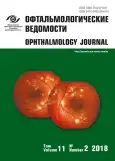The state of conjunctival flora and its susceptibility to “Vitabakt” in cataract patients compared to other antibiotics used in ophthalmologic practice
- Authors: Pirogov Y.I.1, Shustrova T.A.1, Oblovatskaya E.S.2, Khromova E.S.1
-
Affiliations:
- “Admiralty Shipyards” Medical Center
- Saint Petersburg State University
- Issue: Vol 11, No 2 (2018)
- Pages: 75-79
- Section: Articles
- URL: https://journals.rcsi.science/ov/article/view/8940
- DOI: https://doi.org/10.17816/OV11275-79
- ID: 8940
Cite item
Full Text
Abstract
The problem of increasing microbial antibiotic resistance antimicrobial requires a detailed study of all antimicrobial drugs’ spectrum of activity. In the available literature, there are no data on microbial flora in vitro susceptibility to picloxydine.
The aim of this study was to study the conjunctival flora composition and its susceptibility to antimicrobial drugs in patients before phacoemulsification, and to detect the conjunctival flora sensitivity to picloxydine in the postoperative period.
Materials and methods. Before phacoemulsification, 117 swabs (116 patients) were taken from the conjunctiva before any drop instil lation. All swabs were examined using the routine cultural method and 14 antibiotics-panel susceptibility testing. Picloxydine susceptibility was tested four times during the postoperative period in 28 patients.
Results. In 66.7%, bacterial growth was obtained preoperatively. All isolates were gram-positive, St. epidermidis was found most frequently (78.8%). In 1 hour after surgery, bacterial growth was obtained in 27.6%. Fluoroquinolones, linezolid, and picloxydine revealed highest efficacy toward St. epidermidis and St. aureus.
Conclusion. Moxifloxacin, linezolid, and picloxydine turned out to be the most effective antimicrobial drugs. Сonjunctival flora was detected in 1 hour after phacoemulsification. Сonjunctival flora remains sensitive to picloxydine during 1 month in the postoperative period.
Full Text
##article.viewOnOriginalSite##About the authors
Yuriy I. Pirogov
“Admiralty Shipyards” Medical Center
Author for correspondence.
Email: visus1@yandex.ru
Surgeon Ophthalmologist (Highest Category), Head of Ophthalmology Department
Russian Federation, Saint PetersburgTatyana A. Shustrova
“Admiralty Shipyards” Medical Center
Email: oft@verficlinic.ru
Bacteriologist (the Highest Category), Head of Bacteriological Department
Russian Federation, Saint PetersburgEvgeniya S. Oblovatskaya
Saint Petersburg State University
Email: e.oblovatskaya@yandex.ru
6th-year Student of Medical Department.
Russian Federation, Saint PetersburgEkaterina S. Khromova
“Admiralty Shipyards” Medical Center
Email: gubaidullina90@mail.ru
Ophthalmologist
Russian Federation, Saint PetersburgReferences
- Астахов Ю.С., Рикс И.А. Современные методы диагностики и лечения конъюнктивитов. – СПб., 2007. [Astakhov YS, Riks IA. Modern methods of diagnosis and treatment of conjunctivitis. Saint Petersburg; 2007. (In Russ.)]
- Поляк М.С., Околов И.Н., Пирогов Ю.И. Антибиотикотерапия в офтальмологии. – СПб.: Нестор-История, 2015. [Polyak MS, Okolov IN, Pirogov YI. Antibiotic therapy in ophthalmology. Saint Petersburg; 2015. (In Russ.)]
- Рациональная фармакотерапия в офтальмологии: Руководство для практикующих врачей / Под ред. Е.А. Егорова. – М.: Литерра, 2004. [Egorov EA, editor. Rational Pharmacotherapy in Ophthalmo logy: A Guide for Practitioners. Moscow: Litterra; 2004. (In Russ.)]
- Barry P, Cordovés L, Gardner S. ESCRS Guidelines for Prevention and Treatment of Endophthalmitis Following Cataract Surgery: Data, Dilemmas and Conclusions. Blackrock: ESCRS; 2013.









